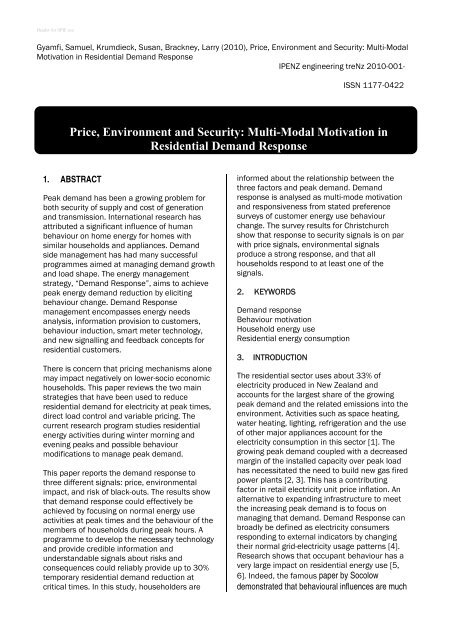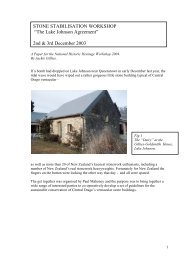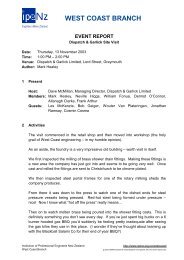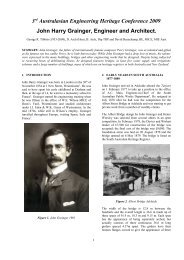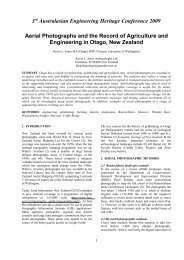Multi-Modal Motivation in Residential Demand Response - ipenz
Multi-Modal Motivation in Residential Demand Response - ipenz
Multi-Modal Motivation in Residential Demand Response - ipenz
You also want an ePaper? Increase the reach of your titles
YUMPU automatically turns print PDFs into web optimized ePapers that Google loves.
Header for SPIE use<br />
Gyamfi, Samuel, Krumdieck, Susan, Brackney, Larry (2010), Price, Environment and Security: <strong>Multi</strong>-<strong>Modal</strong><br />
<strong>Motivation</strong> <strong>in</strong> <strong>Residential</strong> <strong>Demand</strong> <strong>Response</strong><br />
IPENZ eng<strong>in</strong>eer<strong>in</strong>g treNz 2010-001-<br />
ISSN 1177-0422<br />
Price, Environment and Security: <strong>Multi</strong>-<strong>Modal</strong> <strong>Motivation</strong> <strong>in</strong><br />
<strong>Residential</strong> <strong>Demand</strong> <strong>Response</strong><br />
1. ABSTRACT<br />
Peak demand has been a grow<strong>in</strong>g problem for<br />
both security of supply and cost of generation<br />
and transmission. International research has<br />
attributed a significant <strong>in</strong>fluence of human<br />
behaviour on home energy for homes with<br />
similar households and appliances. <strong>Demand</strong><br />
side management has had many successful<br />
programmes aimed at manag<strong>in</strong>g demand growth<br />
and load shape. The energy management<br />
strategy, “<strong>Demand</strong> <strong>Response</strong>”, aims to achieve<br />
peak energy demand reduction by elicit<strong>in</strong>g<br />
behaviour change. <strong>Demand</strong> <strong>Response</strong><br />
management encompasses energy needs<br />
analysis, <strong>in</strong>formation provision to customers,<br />
behaviour <strong>in</strong>duction, smart meter technology,<br />
and new signall<strong>in</strong>g and feedback concepts for<br />
residential customers.<br />
There is concern that pric<strong>in</strong>g mechanisms alone<br />
may impact negatively on lower-socio economic<br />
households. This paper reviews the two ma<strong>in</strong><br />
strategies that have been used to reduce<br />
residential demand for electricity at peak times,<br />
direct load control and variable pric<strong>in</strong>g. The<br />
current research program studies residential<br />
energy activities dur<strong>in</strong>g w<strong>in</strong>ter morn<strong>in</strong>g and<br />
even<strong>in</strong>g peaks and possible behaviour<br />
modifications to manage peak demand.<br />
This paper reports the demand response to<br />
three different signals: price, environmental<br />
impact, and risk of black-outs. The results show<br />
that demand response could effectively be<br />
achieved by focus<strong>in</strong>g on normal energy use<br />
activities at peak times and the behaviour of the<br />
members of households dur<strong>in</strong>g peak hours. A<br />
programme to develop the necessary technology<br />
and provide credible <strong>in</strong>formation and<br />
understandable signals about risks and<br />
consequences could reliably provide up to 30%<br />
temporary residential demand reduction at<br />
critical times. In this study, householders are<br />
<strong>in</strong>formed about the relationship between the<br />
three factors and peak demand. <strong>Demand</strong><br />
response is analysed as multi-mode motivation<br />
and responsiveness from stated preference<br />
surveys of customer energy use behaviour<br />
change. The survey results for Christchurch<br />
show that response to security signals is on par<br />
with price signals, environmental signals<br />
produce a strong response, and that all<br />
households respond to at least one of the<br />
signals.<br />
2. KEYWORDS<br />
<strong>Demand</strong> response<br />
Behaviour motivation<br />
Household energy use<br />
<strong>Residential</strong> energy consumption<br />
3. INTRODUCTION<br />
The residential sector uses about 33% of<br />
electricity produced <strong>in</strong> New Zealand and<br />
accounts for the largest share of the grow<strong>in</strong>g<br />
peak demand and the related emissions <strong>in</strong>to the<br />
environment. Activities such as space heat<strong>in</strong>g,<br />
water heat<strong>in</strong>g, light<strong>in</strong>g, refrigeration and the use<br />
of other major appliances account for the<br />
electricity consumption <strong>in</strong> this sector [1]. The<br />
grow<strong>in</strong>g peak demand coupled with a decreased<br />
marg<strong>in</strong> of the <strong>in</strong>stalled capacity over peak load<br />
has necessitated the need to build new gas fired<br />
power plants [2, 3]. This has a contribut<strong>in</strong>g<br />
factor <strong>in</strong> retail electricity unit price <strong>in</strong>flation. An<br />
alternative to expand<strong>in</strong>g <strong>in</strong>frastructure to meet<br />
the <strong>in</strong>creas<strong>in</strong>g peak demand is to focus on<br />
manag<strong>in</strong>g that demand. <strong>Demand</strong> <strong>Response</strong> can<br />
broadly be def<strong>in</strong>ed as electricity consumers<br />
respond<strong>in</strong>g to external <strong>in</strong>dicators by chang<strong>in</strong>g<br />
their normal grid-electricity usage patterns [4].<br />
Research shows that occupant behaviour has a<br />
very large impact on residential energy use [5,<br />
6]. Indeed, the famous paper by Socolow<br />
demonstrated that behavioural <strong>in</strong>fluences are much
larger than the impact of <strong>in</strong>tr<strong>in</strong>sic differences <strong>in</strong><br />
build<strong>in</strong>g materials and energy consum<strong>in</strong>g<br />
appliances. <strong>Demand</strong> <strong>Response</strong> is a type of<br />
<strong>Demand</strong> Side Management strategy aimed at<br />
short-term behaviour changes to ma<strong>in</strong>ta<strong>in</strong> the<br />
safe marg<strong>in</strong> between generation and/or<br />
distribution capacity. A secondary goal of<br />
<strong>Demand</strong> <strong>Response</strong> programmes is to reduce<br />
<strong>in</strong>flation of electricity unit price.<br />
Two basic strategies have been used <strong>in</strong> America<br />
and Europe to control residential peak load:<br />
time-of-use pric<strong>in</strong>g and direct load control. The<br />
time-of-use demand response approach relies<br />
on a clear pric<strong>in</strong>g signal, usually communicated<br />
via the monthly power bill. Price differentials an<br />
order of magnitude higher at peak times are<br />
needed <strong>in</strong> order to <strong>in</strong>fluence customers to shift<br />
their electricity usage from peak to off-peak<br />
hours. The most common residential pric<strong>in</strong>g<br />
signal is a fixed tariff structure with higher unit<br />
prices dur<strong>in</strong>g the usual peak periods. Customer<br />
response <strong>in</strong> this case is driven by an <strong>in</strong>ternal<br />
economic decision-mak<strong>in</strong>g process, and the load<br />
modifications are entirely voluntary. <strong>Residential</strong><br />
customers have rarely been subject to a spot<br />
market price. However, these types of tariffs<br />
have been criticized for equity reasons as<br />
households who do not own large energy<br />
consum<strong>in</strong>g appliances like a heat pump do not<br />
qualify to benefit from the programme. Also, the<br />
levels of price that may be required to achieve<br />
the needed response can be higher than what is<br />
affordable to lower socio-economic households<br />
[7].<br />
Direct load control, unlike the time-of-use pric<strong>in</strong>g<br />
approach, offers households cost <strong>in</strong>centives <strong>in</strong><br />
exchange for the utility <strong>in</strong>terruption of some<br />
large energy consum<strong>in</strong>g household appliances.<br />
Air conditioners are commonly ripple controlled<br />
dur<strong>in</strong>g summer peak air condition<strong>in</strong>g demand <strong>in</strong><br />
the USA and Europe. Ripple control of water<br />
heat<strong>in</strong>g cyl<strong>in</strong>ders is a direct load control program<br />
on some networks <strong>in</strong> New Zealand. It has been<br />
very successful <strong>in</strong> manag<strong>in</strong>g residential peak<br />
demand <strong>in</strong> Christchurch [8]. However, the supply<br />
<strong>in</strong>terruption is seldom communicated to<br />
customers, and depend<strong>in</strong>g on their hot water<br />
usage patterns, Christchurch residents have<br />
experience “cold showers” as a result.<br />
In this paper, reduction of residential peak<br />
demand through voluntary demand response<br />
participation is explored. The relationships are<br />
explored between peak demand and three<br />
important factors: cost (price), environment<br />
(CO2) and security (blackouts) to persuade<br />
household consumers to change their peakelectricity<br />
usage behaviour. The research<br />
reported <strong>in</strong> this paper is the first step <strong>in</strong> a project<br />
to develop novel smart, <strong>in</strong>formative, and<br />
feedback-enabled meter<strong>in</strong>g technology.<br />
Information, socialisation and feedback are<br />
necessary <strong>in</strong> order to <strong>in</strong>fluence human<br />
behaviour [7]. The facts about network<br />
operation, generation, and costs of peak supply<br />
would represent the <strong>in</strong>formation component.<br />
Real-time connection to generation status,<br />
current price and CO2 emissions would<br />
represent the socialisation component. A signal<br />
for load reduction due to exceed<strong>in</strong>g system<br />
conditions of pre-set capacity marg<strong>in</strong>, price or<br />
CO2 limits would be given via the new “smart”<br />
meter <strong>in</strong>terface, and feedback about collective<br />
response and system condition would be given.<br />
This <strong>in</strong>tegrated behaviour modification design is<br />
a new approach, requir<strong>in</strong>g research <strong>in</strong> multimode<br />
demand response elasticities.<br />
A survey of residences was done <strong>in</strong> Christchurch<br />
to determ<strong>in</strong>e customer will<strong>in</strong>gness to adjust their<br />
normal w<strong>in</strong>ter morn<strong>in</strong>g and/or even<strong>in</strong>g activities<br />
<strong>in</strong> response to each of the three factors; price,<br />
environmental impacts and supply security. This<br />
survey focused on the <strong>in</strong>formation and<br />
socialisation aspects of the larger research and<br />
development programme. Customers stated<br />
appliance use modification preferences at peak<br />
times will be used to determ<strong>in</strong>e the maximum<br />
possible residential demand reduction. The<br />
power reduction result<strong>in</strong>g from stated activity<br />
change as a function of the strength of the<br />
signal is the demand response elasticity.<br />
Household response and motivation with respect<br />
to each factor are reported. The results show<br />
that by broaden<strong>in</strong>g the scope of <strong>in</strong>formation<br />
conveyed to the residential customers the<br />
system-wide demand response could be<br />
substantially greater than for the price signal<br />
alone.<br />
4 DEMAND RESPONSE EXPERIENCE IN<br />
THE RESIDENTIAL SECTOR<br />
Historically, utilities have used two strategies to<br />
reduce residential peak load: direct load control<br />
programs and variable pric<strong>in</strong>g tariffs. Direct load<br />
control programs are typically mass-market<br />
programs directed at residential customers. A<br />
customer agrees to allow the utility to control the<br />
mode of operation of a specific electrical appliance<br />
and receives a price <strong>in</strong>centive. The most frequently<br />
controlled residential end-use appliances are<br />
central air conditioners, water heat<strong>in</strong>g cyl<strong>in</strong>ders,<br />
electric space heaters with storage features, and
non-essential light<strong>in</strong>g. The use of direct load<br />
control differs between geographical areas and<br />
depends on the load pattern of the location. In<br />
Southern Australia, direct load control is used to<br />
control summer air conditioners [9]. In New<br />
Zealand, direct control is used to control hot<br />
water heat<strong>in</strong>g cyl<strong>in</strong>ders <strong>in</strong> the w<strong>in</strong>ter. In<br />
Christchurch for <strong>in</strong>stance, the network company<br />
Orion is able to manage residential load rang<strong>in</strong>g<br />
from 125 – 150 MW by the use of ripple control<br />
[8]. Orion requires all new residential water<br />
heat<strong>in</strong>g cyl<strong>in</strong>ders on the network to be ripple<br />
controlled because of constra<strong>in</strong>ts on network<br />
capacity [10]. Despite its effectiveness, direct<br />
load control programs have been criticized for<br />
the follow<strong>in</strong>g reason: they offer fixed f<strong>in</strong>ancial<br />
<strong>in</strong>centives for unmeasured load. For example,<br />
the bill credit given by the utility is the same<br />
regardless of the amount of load reduction<br />
accessed by the utility. In Orion’s case, the<br />
benefit is l<strong>in</strong>ked to the ‘economy rate’. All<br />
customers on the ‘economy rate’ receive the<br />
same credit on their monthly electricity bill [11].<br />
The other residential peak demand reduction<br />
program is time variable pric<strong>in</strong>g. This category<br />
employs different pric<strong>in</strong>g mechanisms <strong>in</strong>clud<strong>in</strong>g<br />
Time-of-Use Pric<strong>in</strong>g, Critical-Peak Pric<strong>in</strong>g, and<br />
Real-Time Pric<strong>in</strong>g. Based on the theory of utility<br />
maximization and consumer rationality, the<br />
proponents of the pric<strong>in</strong>g concept assume that<br />
<strong>in</strong>dividuals seek to maximize utility given a<br />
budget constra<strong>in</strong>t. A decision outcome with<br />
higher utility will be consistently preferred to an<br />
alternative outcome with lower utility [12, 13].<br />
Instead of directly controll<strong>in</strong>g customer load at<br />
peak times, the pric<strong>in</strong>g mechanism aims at<br />
<strong>in</strong>fluenc<strong>in</strong>g customers to shift the usage of<br />
electricity from peak to off-peak hours by<br />
charg<strong>in</strong>g a high price per unit of electricity<br />
consumed dur<strong>in</strong>g peak hours. Consumers<br />
receive relevant price signals as the unit cost<br />
reflects the actual cost of electricity at the time it<br />
was provided.<br />
However, there is a wealth of experimental and<br />
field evidence that <strong>in</strong>dividuals do not make<br />
consistently rational decisions [14]. This is<br />
expla<strong>in</strong>ed by the fact that most people are only<br />
partly rational, and <strong>in</strong> fact emotional or irrational<br />
<strong>in</strong> the rema<strong>in</strong><strong>in</strong>g part of their actions. People’s<br />
energy-sav<strong>in</strong>g decisions are therefore said to be<br />
best characterized by the concept of ‘bounded<br />
rationality’ [13] where one bound assumes the<br />
rational behaviour and the other bound assumes<br />
<strong>in</strong>dividual decisions to be subject to constra<strong>in</strong>ts<br />
on their habits, <strong>in</strong>tentions, resources and ability<br />
to process <strong>in</strong>formation. This theory has been<br />
used to expla<strong>in</strong> the energy efficiency gap that is<br />
repeatedly identified <strong>in</strong> economic-eng<strong>in</strong>eer<strong>in</strong>g<br />
studies. The potential reduction <strong>in</strong> energy<br />
demand from the adoption of more efficient<br />
technology has rema<strong>in</strong>ed underutilized despite<br />
significant lifetime sav<strong>in</strong>g and attractive payback<br />
time. This theory may also be used <strong>in</strong> demand<br />
response to expla<strong>in</strong> peak demand price<br />
unresponsiveness. Of course, <strong>in</strong> the case of<br />
residential energy consumers, the activities<br />
tak<strong>in</strong>g place dur<strong>in</strong>g peak times may not be<br />
rationally curtailed or delayed <strong>in</strong> order to avoid a<br />
small marg<strong>in</strong>al cost <strong>in</strong>crease. We would not<br />
expect people to leave d<strong>in</strong>ner half cooked, to<br />
endure a cold home if health is at risk, or switch<br />
to candles.<br />
Time vary<strong>in</strong>g pric<strong>in</strong>g is employed <strong>in</strong> New Zealand<br />
for large <strong>in</strong>dustrial and commercial users with<br />
special half-hour <strong>in</strong>terval meter<strong>in</strong>g that records<br />
customer demand dur<strong>in</strong>g peak times. This type<br />
of pric<strong>in</strong>g is currently not available for the<br />
residential customers. The residential sector<br />
enjoys a flat or split rate for electricity<br />
consumption. They can, however, decide<br />
between night and day-time rates or put some<br />
heat<strong>in</strong>g appliances on night rate. Even if people<br />
would make economically “rational” decisions<br />
and reduce the use of electricity at peak times,<br />
one issue still rema<strong>in</strong>s – impact of price on<br />
lower-socio economic households. These<br />
households use less electricity than the average<br />
consumer, and as a result, their ability to<br />
conserve is lower [15]. Also, when confronted<br />
with an <strong>in</strong>crease <strong>in</strong> energy costs, lower-<strong>in</strong>come<br />
families tend to make “lifestyle cutbacks”[16].<br />
Therefore us<strong>in</strong>g a pric<strong>in</strong>g mechanism to achieve<br />
demand response will not be consistent with all<br />
the pr<strong>in</strong>ciples of rate design such as the<br />
promotion of social equity and affordability to<br />
low <strong>in</strong>come households [17].<br />
5 MULTI-MODAL DEMAND RESPONSE<br />
MOTIVATION<br />
The limitations of price and direct load control<br />
mechanisms provide an opportunity to explore<br />
other ways to achieve effective demand<br />
response <strong>in</strong> the residential sector. Energy<br />
demand is <strong>in</strong>fluenced by external factors that<br />
may also stimulate <strong>in</strong>dividuals or householders<br />
to take on energy sav<strong>in</strong>g measures. These<br />
external factors <strong>in</strong>clude not only <strong>in</strong>creased price<br />
but also water or fuel shortages, energy crisis and<br />
environmental concerns. This study explores the<br />
customer response to three external factors: cost<br />
(price), environment (CO2) and security (blackout).
The potential impact of each of these factors as<br />
a customer peak reduction motivator is<br />
determ<strong>in</strong>ed through a household survey <strong>in</strong><br />
Christchurch. The elasticity of demand with<br />
respect to price, environment and security is<br />
determ<strong>in</strong>ed through the survey. This paper<br />
describes the first results from a larger trial. Indepth<br />
analysis of the residential peak electricity<br />
demand is be<strong>in</strong>g carried out by develop<strong>in</strong>g an<br />
activity system model calibrated to the<br />
residential sector <strong>in</strong> Christchurch by us<strong>in</strong>g the<br />
survey data. The responsiveness to motivational<br />
factors will be used to calculate electricity<br />
demand reduction, and to <strong>in</strong>form concepts for<br />
new communication technologies that could be<br />
used to manage residential peak demand.<br />
5.1 THE MOTIVATION FACTORS AND THE<br />
USER IN PAST STUDIES<br />
The potential of us<strong>in</strong>g price as a feedback on<br />
energy consumption to reduce demand has<br />
been well emphasized <strong>in</strong> many studies. The<br />
analysis of residential customer response to<br />
price has <strong>in</strong>volved estimat<strong>in</strong>g the magnitude of<br />
customer load change and calculat<strong>in</strong>g the value<br />
of elasticity parameters that characterize the<br />
degree of price responsiveness. There have<br />
been some large and small scale experiments to<br />
study the impacts of high prices on electricity<br />
demand dur<strong>in</strong>g peak hours. One of the large<br />
scale experiments conducted <strong>in</strong> the residential<br />
sector is the California State-Wide Pric<strong>in</strong>g Pilot<br />
conducted to test the impact of several pric<strong>in</strong>g<br />
structures on peak demand [18]. A total of<br />
2,500 customers were <strong>in</strong>volved <strong>in</strong> the<br />
experiments that ran from July 2003 to<br />
December 2004. This experiment found average<br />
demand reduction of 13% for low-demand<br />
customers (ma<strong>in</strong>ly residential customers with<br />
demand less than 20 kW). The estimated price<br />
elasticity (kW change per unit price change) of<br />
substitution varied from -0.04 to -0.13 for peak<br />
to off-peak price ratio of 3 to 6 [18]. Another<br />
experiment conducted <strong>in</strong> Canada by Ontario<br />
Hydro found overall sav<strong>in</strong>g of 13% across the 25<br />
homes that were <strong>in</strong>volved [19]. A review of past<br />
studies drawn from North America found price<br />
elasticities between -0.12 to -0.35 [20]. Note<br />
that negative elasticity means a demand<br />
reduction <strong>in</strong> response to a price <strong>in</strong>crease.<br />
environmentalists <strong>in</strong> many energy conservation<br />
campaigns, we have not come across a demand<br />
response study that uses the emissions to the<br />
environment at peak times as a signal to<br />
persuade consumers to reduce demand. In New<br />
Zealand, peak demand is the underly<strong>in</strong>g reason<br />
for new gas generation, but on a daily basis, the<br />
peak demand is met by peak<strong>in</strong>g hydro. However,<br />
<strong>in</strong> Christchurch, there are about 90 diesel<br />
generators owned by the city council and other<br />
<strong>in</strong>stitutions that are used to meet demand<br />
dur<strong>in</strong>g peak hours [22]. This is due to the<br />
transmission constra<strong>in</strong>t <strong>in</strong>to the city. If<br />
residential customers <strong>in</strong> Christchurch could<br />
reduce their demand at peak times, the use of<br />
these diesel generators dur<strong>in</strong>g peak demand<br />
hours would be reduced and hence a direct<br />
reduction <strong>in</strong> CO2 emissions and local air<br />
pollution would be achieved. If peak demand <strong>in</strong><br />
the country as a whole were to be managed so<br />
as to limit growth, the need for gas and coal<br />
generation could be reduced.<br />
Security of electricity supply refers to the ability<br />
of the power system to provide electricity to endusers<br />
with a specified level of <strong>in</strong>terruption and<br />
quality <strong>in</strong> a susta<strong>in</strong>able manner, relat<strong>in</strong>g to the<br />
exist<strong>in</strong>g standards and contractual agreements<br />
at the po<strong>in</strong>ts of delivery [23]. It is the<br />
responsibility of the different sectors of the<br />
<strong>in</strong>dustry to ensure supply security. There is a<br />
direct relationship between peak demand and<br />
supply security. This is often expressed <strong>in</strong> terms<br />
of Loss of Load Probability (LOLP). This LOLP is<br />
higher at peak demand hours than at off-peak<br />
hours. L<strong>in</strong>k<strong>in</strong>g residential behaviour to social<br />
consequences, such as roll<strong>in</strong>g blackouts that<br />
could endanger the health and safety of some<br />
people, can provide extra impetus to the peak<br />
demand reduction. In New Zealand, low<br />
precipitation levels or ma<strong>in</strong>tenance on large<br />
generation units can cause supply security<br />
issues. Examples of other places where the<br />
security factor has been used to achieve<br />
demand reduction <strong>in</strong>clude France, dur<strong>in</strong>g the<br />
2003 heat waves [24], and <strong>in</strong> California dur<strong>in</strong>g<br />
the state’s 2001 energy crisis [25]. Table 1<br />
shows the most important motivat<strong>in</strong>g factors for<br />
conserv<strong>in</strong>g energy given by respondents a survey<br />
that was conducted after the energy<br />
conservation campaign <strong>in</strong> California <strong>in</strong> 2001.<br />
There is a direct relationship between peak<br />
demand and environmental emissions. This<br />
relationship depends on the generation mix and<br />
how they are dispatched to the market [21].<br />
While adverse environmental impact of energy<br />
production and use have been used by
Respondents<br />
<strong>Motivation</strong> for reduc<strong>in</strong>g demand (%)<br />
Very important to stop energy<br />
suppliers from overcharg<strong>in</strong>g 79%<br />
Us<strong>in</strong>g energy resources wisely 78%<br />
Keep<strong>in</strong>g bills down 77%<br />
Try<strong>in</strong>g to avoid blackouts 77%<br />
Do<strong>in</strong>g our part 69%<br />
Qualify for utility rebate 33%<br />
TABLE 1: <strong>Motivation</strong>s quoted as important by participants<br />
dur<strong>in</strong>g the “Flex Your Power” Energy Conservation<br />
Campaign <strong>in</strong> California after 2001 energy crisis<br />
6 STUDY METHOD<br />
In this study, a survey was conducted to<br />
determ<strong>in</strong>e how household energy use behaviour<br />
could be <strong>in</strong>fluenced by three factors: price,<br />
environmental impact, and security. Energy use<br />
behaviour is a factor of two components: the<br />
activities be<strong>in</strong>g carried out and the appliances<br />
be<strong>in</strong>g used. The survey collected data to<br />
correlate network demand reduction with<br />
particular behaviour changes: curtail or shift<br />
activities, conserve by turn<strong>in</strong>g off un-needed<br />
appliances. Stated behaviour change preference<br />
is used to estimate the possible peak demand<br />
reduction. The survey questions were divided<br />
<strong>in</strong>to two ma<strong>in</strong> sections: household <strong>in</strong>formation<br />
and stated preferences for sav<strong>in</strong>g electricity at<br />
peak times.<br />
This paper reports one survey conducted <strong>in</strong><br />
Halswell, a suburb of Christchurch. This area is<br />
unique, <strong>in</strong> that it has its own residential power<br />
feeder. This feeder was selected <strong>in</strong> consultation<br />
with Orion Networks, a power distribution<br />
company <strong>in</strong> Christchurch so that the real power<br />
consumption data could be used <strong>in</strong> future<br />
modell<strong>in</strong>g. The homes <strong>in</strong> the Halswell suburb<br />
were all built between 15-8 years ago, so are<br />
relatively new and all <strong>in</strong> the same condition. All<br />
homes are <strong>in</strong>sulated and heated with electricity.<br />
All water heat<strong>in</strong>g is supplied by electricity, and<br />
roughly half of the residences <strong>in</strong> the suburb have<br />
water cyl<strong>in</strong>ders on ripple control. Figure 1 shows<br />
the average power demand on the Halswell<br />
feeder for week days, Saturday and Sunday <strong>in</strong><br />
July 2006. The morn<strong>in</strong>g and even<strong>in</strong>g activity<br />
peaks are evident, as is the ripple control load<br />
reduction at 6:00pm. The high peak <strong>in</strong> the<br />
middle of the night represents the network<br />
control of all water cyl<strong>in</strong>ders and nightstore<br />
heaters. The high residential load at night is not<br />
a problem for the network as commercial and<br />
light <strong>in</strong>dustrial loads are not present.<br />
The survey was placed <strong>in</strong> an envelope addressed<br />
to “resident” along with a stamped return<br />
envelope, and hand delivered to every mailbox <strong>in</strong><br />
the Halswell subdivision. In total just over 400<br />
residential customers are on the Halswell<br />
electricity feeder. The respondents were offered<br />
the chance to be <strong>in</strong> a draw to w<strong>in</strong> one of 10<br />
CentametersTM if they returned the survey and<br />
selected a box to be <strong>in</strong> the draw. A Centameter is<br />
a real-time power monitor with display unit <strong>in</strong> the<br />
house valued at $140. The household response<br />
rate was 16.3% with one survey returned without<br />
complet<strong>in</strong>g. The number of completed surveys<br />
was statistically significant sample for the<br />
number of households. No follow-up rem<strong>in</strong>der or<br />
prompt was carried out after the <strong>in</strong>itial mailbox<br />
drop. The respondents’ personal <strong>in</strong>formation<br />
<strong>in</strong>dicated a good demographic correlation with<br />
the general Christchurch population.
1800<br />
1600<br />
1400<br />
1200<br />
Load (kW)<br />
1000<br />
800<br />
Typical Sunday<br />
Typical Weekday<br />
Typical Saturday<br />
600<br />
400<br />
200<br />
0<br />
1 3 5 7 9 11 13 15 17 19 21 23 25 27 29 31 33 35 37 39 41 43 45 47<br />
Time (half-hours)<br />
FIGURE 1: Average electricity demand for the 400 residents <strong>in</strong> the Halswell suburb dur<strong>in</strong>g the w<strong>in</strong>ter<br />
month of July 2006. The last peak represents network controlled water heat<strong>in</strong>g loads. Time is quoted<br />
<strong>in</strong> 30 m<strong>in</strong>utes <strong>in</strong>tervals from midnight<br />
The survey <strong>in</strong>cluded a cover letter that expla<strong>in</strong>ed<br />
the research purpose and details of ethics<br />
approval and confidentiality. There was also a<br />
plot of the Christchurch power demand on the<br />
day of the Earth Hour event <strong>in</strong> order to illustrate<br />
the concept of demand response. A short<br />
explanation was given <strong>in</strong> the cover letter about<br />
the high cost of produc<strong>in</strong>g peak power, the<br />
higher CO2 emissions <strong>in</strong> Christchurch if diesel<br />
generators were needed, and the risks of power<br />
outage if demand exceeds the supply capacity of<br />
the grid.<br />
6.1 DEMAND RESPONSE SURVEY STRUCTURE<br />
To understand how electricity is used <strong>in</strong><br />
households, we asked participants to tell us<br />
about how they use power to carry out their<br />
normal daily activities dur<strong>in</strong>g w<strong>in</strong>ter morn<strong>in</strong>g and<br />
even<strong>in</strong>g peak hours. Lists of typical appliances<br />
associated with kitchen/d<strong>in</strong><strong>in</strong>g, bedroom,<br />
bathroom and lounge were provided with room<br />
to <strong>in</strong>sert other appliances. Participants were<br />
asked to fill <strong>in</strong> the number of appliances they<br />
have, and to <strong>in</strong>dicate whether it would be <strong>in</strong> use<br />
dur<strong>in</strong>g the morn<strong>in</strong>g and/or even<strong>in</strong>g hours. The<br />
reported appliance load<strong>in</strong>g and activity-related<br />
appliance use were used to develop a model of<br />
the electricity demand for the 400 household<br />
feeder. Nom<strong>in</strong>al power consumption rates for<br />
appliances and standard appliance penetration<br />
probabilities were used to develop a load model<br />
which was further adjusted to fit the actual<br />
residential feeder data. This represents the “no<br />
response” power load.<br />
As a control, we asked participants about the<br />
appliances they would switch off <strong>in</strong> a scenario<br />
where they are allocated a limited amount of<br />
power, less than what is required to carry out<br />
their normal household activities, due to an<br />
emergency situation. By us<strong>in</strong>g the nom<strong>in</strong>al<br />
electricity demand capacities of the appliances,<br />
the total possible demand reduction dur<strong>in</strong>g peak<br />
hours was calculated from customers’ stated<br />
preferences <strong>in</strong> reduc<strong>in</strong>g demand dur<strong>in</strong>g an<br />
unspecified emergency situation. This restricted,<br />
yet voluntary demand response for the morn<strong>in</strong>g<br />
peak represented 40.9% of 1 July 2006 morn<strong>in</strong>g<br />
peak load while that of the even<strong>in</strong>g of the same<br />
day represented 28.8% of the even<strong>in</strong>g peak<br />
load. In the scenario it was expla<strong>in</strong>ed that the<br />
load or activity could be postponed and resumed<br />
after the peak period.<br />
The importance of price, environment and<br />
security as household participants’ electricity<br />
demand reduction motivation factors were<br />
explored through the f<strong>in</strong>al section of the survey.<br />
Customers were first asked to rank each of the<br />
motivat<strong>in</strong>g factors on a scale of 1 (lowest) to 5<br />
(highest) <strong>in</strong> terms of how they would be<br />
<strong>in</strong>fluenced by each of the factors. The three<br />
factors were then explored separately.<br />
Participants were first asked what they would<br />
consider to be a “high” price rise, then asked<br />
how they would modify their power consumption<br />
if the price dur<strong>in</strong>g peak times went up to that<br />
high price. Next, participants were asked to give<br />
a range of power generation from non-renewable<br />
fuels that they considered to be “high”. Aga<strong>in</strong><br />
they were asked what they would modify if the<br />
carbon emissions dur<strong>in</strong>g peak times became<br />
high due to fossil fuel use. F<strong>in</strong>ally, participants<br />
were asked how many power disruptions <strong>in</strong> the<br />
form of brown-outs or black-outs they considered<br />
to be “high” over the course of a year. They were<br />
then asked to <strong>in</strong>dicate demand reduction measures<br />
they would take if the risk of power disruption was<br />
high.
6.2 ANALYSIS<br />
The first question about relative importance of<br />
the three factors was analysed by plott<strong>in</strong>g the<br />
responses and then calculat<strong>in</strong>g a weight<strong>in</strong>g<br />
factor from the data. The total score of each of<br />
the factors was determ<strong>in</strong>ed from the equation:<br />
W f<br />
=<br />
n<br />
w fj<br />
j = 1<br />
∑<br />
(1)<br />
Where Wf represents the numerical importance<br />
of the factor f and wf is the score given by the jth<br />
customer to that factor.<br />
Elasticity is commonly used <strong>in</strong> economic<br />
analysis. Elasticity refers to a measure of the<br />
responsiveness <strong>in</strong> the quantity demanded to<br />
changes <strong>in</strong> the price. In this analysis we are<br />
<strong>in</strong>terested <strong>in</strong> the responsiveness to the factor. In<br />
future work the electricity load modell<strong>in</strong>g will be<br />
used to calculate electricity demand reduction<br />
from survey responses. The factor<br />
responsiveness for this survey was calculated as<br />
the ratio of the cumulative percentage of<br />
participants respond<strong>in</strong>g to an associated change<br />
<strong>in</strong> each of the factors. The price change is<br />
expressed as percent <strong>in</strong>crease from current unit<br />
price dur<strong>in</strong>g the peak period. The environmental<br />
impact factor was expressed as a total<br />
percentage of non-renewable generation rather<br />
than as a change from a non-peak condition.<br />
This was done because many South Island<br />
residential customers perceive that their power<br />
supply is provided by hydroelectricity alone. The<br />
security of supply factor was expressed as a<br />
total number of power supply disruptions <strong>in</strong> a<br />
year. As there have not been any blackouts <strong>in</strong><br />
Christchurch for several years, even one event<br />
represents a 100% change from current status.<br />
Thus, the calculation of responsiveness, Rf, to<br />
each factor is calculated from the follow<strong>in</strong>g three<br />
equations:<br />
Rprice = (Cumulative Participant <strong>Response</strong>) ÷ (%<br />
Price Increase)<br />
Renvironment = (Cumulative Participant<br />
<strong>Response</strong>) ÷ (% Non-Renewable Generation)<br />
Rsecurity = (Cumulative Participant <strong>Response</strong>) ÷<br />
(Number of Power Supply Disruptions)<br />
As mentioned earlier, this paper provides the<br />
first results that show responsiveness to<br />
7 RESULTS<br />
Figure 2 shows the direct response from the<br />
participants <strong>in</strong> response to the question:<br />
Percentage of Households Respond<strong>in</strong>g<br />
60%<br />
50%<br />
40%<br />
30%<br />
20%<br />
10%<br />
0%<br />
How important are each of the three<br />
follow<strong>in</strong>g factors <strong>in</strong> relation to how you<br />
might change your power use dur<strong>in</strong>g peak<br />
times?<br />
Price<br />
Environmental<br />
Security<br />
1 2 3 4 5<br />
<strong>Response</strong> Scale from 1 (lowest) to 5 (highest)<br />
FIGURE 2: Household participants’ response rate to the<br />
three motivation factors, at each importance level<br />
An importance weight<strong>in</strong>g for each factor was<br />
calculated from the data us<strong>in</strong>g equation 1. The<br />
results show that that price is a stronger<br />
household behaviour change motivator (82%)<br />
followed by security (79%) and then the<br />
environment (64%).<br />
To determ<strong>in</strong>e the responsiveness of the demand<br />
for electricity at peak times to the changes <strong>in</strong> the<br />
price, the environment (CO2 emission) and<br />
security (blackouts), the follow<strong>in</strong>g three<br />
questions were asked:<br />
1. If your electricity price were to go up,<br />
what percentage <strong>in</strong>crease above your<br />
last bill would you consider to be large?<br />
2. What percentage of non-renewable<br />
power generation (e.g. coal, gas, and<br />
diesel) would you consider to be too<br />
high?<br />
3. How many power cuts on a w<strong>in</strong>ter<br />
morn<strong>in</strong>g or even<strong>in</strong>g would you consider<br />
to be too many over the w<strong>in</strong>ter season?<br />
Table 2 shows the response of participants to<br />
these different scenarios. In Table 2, 60% of<br />
participants said that a 10% price <strong>in</strong>crease<br />
would be considered high. This is a strong
esponse to a small change and <strong>in</strong>dicated by the<br />
large price responsiveness of 6.0. The number<br />
of participants with a low response to price<br />
change was very small, e.g. only 4% thought a<br />
price rise of more than 20% was high.<br />
Just over one third of people said that 10% fossil<br />
fuel power generation would be too high.<br />
Cumulatively, the Christchurch customer<br />
tolerance for non-renewable generation is quite<br />
low, with 78% of participants <strong>in</strong>dicat<strong>in</strong>g that 30%<br />
non-renewable generation is too high. This is<br />
<strong>in</strong>terest<strong>in</strong>g consider<strong>in</strong>g that it represents the<br />
current generation mix. This response may<br />
represent some misunderstand<strong>in</strong>g of how the<br />
New Zealand power system operates. The<br />
environmental responsiveness ranges from<br />
around 3.5 to 1.8.<br />
The tolerance for power supply disruptions was<br />
found to be very low for Christchurch residents.<br />
This is <strong>in</strong>terest<strong>in</strong>g as there have been very few<br />
power outages <strong>in</strong> the area. More than half of the<br />
participants stated that one power disruption<br />
was too many. Accord<strong>in</strong>g to the responsiveness<br />
equations, the responsiveness to supply security<br />
ranged from 62 to 38.<br />
Price Increase<br />
Dur<strong>in</strong>g Peak<br />
Time 10% 20% 30% 40% 50% NA<br />
Households 60% 32% 2% 2% 0% 4%<br />
Respond<strong>in</strong>g<br />
Cumulative 60% 92% 94% 96% 96% 4%<br />
<strong>Response</strong><br />
Price<br />
6.0 4.6 3.1 2.4<br />
Responsiveness<br />
Non-<br />
Renewable<br />
Fraction<br />
Dur<strong>in</strong>g Peak<br />
Time<br />
10% 20% 30% 40% 50%<br />
NA<br />
Households 35% 33% 10% 6% 5% 11%<br />
Respond<strong>in</strong>g<br />
Cumulative 35% 68% 78% 84% 89% 11%<br />
<strong>Response</strong><br />
Environmental 3.5 3.4 2.6 2.1 1.8<br />
Responsiveness<br />
Security of<br />
Supply:<br />
1 2 >2 NA<br />
Number of<br />
Power Cuts<br />
Households 62% 14% 14% 10%<br />
Respond<strong>in</strong>g<br />
Cumulative 62% 76% 90%<br />
response<br />
Security<br />
62 38 NA NA<br />
Responsiveness<br />
TABLE: 2 Satisfaction levels of participants, to the factor<br />
variations<br />
8 DISCUSSION<br />
Researchers <strong>in</strong> demand response need to<br />
recognize that high prices alone will not necessarily<br />
create the conditions needed to achieve effective<br />
peak demand management that could be reliably<br />
deployed to reduce the need for generation and<br />
transmission <strong>in</strong>frastructure. A range of factors could<br />
be used to <strong>in</strong>fluence people’s energy use behaviour<br />
but price is the only factor that has been used<br />
<strong>in</strong>ternationally. The objective of demand response<br />
is to reduce electricity demand dur<strong>in</strong>g peak hours.<br />
The reductions are temporary and may represent<br />
simply shift<strong>in</strong>g to an off peak time, improved<br />
efficiency, conservation or change of activity. The<br />
benefits of demand response to consumers <strong>in</strong> all<br />
sectors <strong>in</strong>clude lower peak price, market discipl<strong>in</strong>e,<br />
reliable electrical service and possibly lower<br />
environmental emissions. Better explanation of all<br />
these benefits to the consumer is necessary to<br />
achieve effective demand response <strong>in</strong> the<br />
residential sector. This study has shown that people<br />
would be motivated to reduce their electricity<br />
demand at peak times if they are <strong>in</strong>formed about<br />
the consequences of meet<strong>in</strong>g their demand at peak<br />
times. Our experiment has shown that people would<br />
be motivated by environmental and security factors<br />
to reduce their electricity demand at peak times.<br />
More research is therefore required to understand<br />
how people would behave <strong>in</strong> terms of reduc<strong>in</strong>g their<br />
electricity demand if feedback <strong>in</strong>formation on<br />
environmental emissions and system security are<br />
sent <strong>in</strong> real time to households as it has been done<br />
for price.<br />
9 REFERENCES<br />
1. Isaacs, N., M. Camilleri, and L. French,<br />
Energy Use <strong>in</strong> New Zealand Households:<br />
Report on year 10 Analysis for the<br />
Household Energy End-use Project<br />
(HEEP), BRANZ Study Report No. SR 155<br />
2007.<br />
2. IEA-c, Energy Policies of IEA Countries:<br />
New Zealand 2005 Review, International<br />
Energy Agency (IEA) Energy Policy for<br />
New Zealand, 2005.<br />
3. IEA-b, Electricity Information, International<br />
Energy Agency (IEA) Electricity Statistics,<br />
2007.
4. Johnston, L., Consumer and Environmental<br />
Benefits of Load <strong>Response</strong>, Synapse<br />
Energy Economics Inc. 22 Pearl Street,<br />
Cambridge, MA 02139, 2001.<br />
5. Socolow, R.H., Sav<strong>in</strong>g Energy <strong>in</strong> the Home:<br />
Pr<strong>in</strong>ceton’s Experiments at Tw<strong>in</strong> Rivers,<br />
Cambridge, MA, USA. Ball<strong>in</strong>ger Publish<strong>in</strong>g<br />
Company, 1978.<br />
6. Socolow, R.H., Sav<strong>in</strong>g Energy <strong>in</strong> the Home:<br />
Pr<strong>in</strong>ceton’s Experiments at Tw<strong>in</strong> Rivers,<br />
Presented at the 'BRANZ' Conference on<br />
Hous<strong>in</strong>g <strong>in</strong>to the Future: Stepp<strong>in</strong>g Towards<br />
Carbon Neutrality Victoria University of<br />
Well<strong>in</strong>gton, New Zealand, 2007.<br />
7. Lutzenhiser, L., Social and Behavioural<br />
Aspects of Energy Use. Annual review<br />
Energy and Environment 1993. 18: p. 247-<br />
89.<br />
8. EECA, Mass Market Load Control - Its Use<br />
and its Potential Use. Report Prepared for<br />
the Energy Efficiency and Conservation<br />
Authority. See the Appendix to the Report<br />
Prepared by Orion Networks, 2004.<br />
9. ETSA, The Electricity Trust of Southern<br />
Australia (ETSA) Utilities <strong>Demand</strong><br />
Management Program. Progress Report,<br />
2007.<br />
10. Oriongroup, How to Use Ripple Signal on<br />
Orion's Network Web 02. Nov. 2008.<br />
, 2008.<br />
12. Wilson, C. and Dowlatabadi, Model of<br />
Decision Mak<strong>in</strong>g and <strong>Residential</strong> Energy<br />
Use. Annual Review Resources and<br />
Environment 2007. 32: p. 169-203.<br />
13. Sanstad, A.H. and R.B. Howarth,<br />
Consumer Rationality and Energy<br />
Efficiency. Proceed<strong>in</strong>gs of the ACEEE 1994<br />
Summer Study on Energy Efficiency <strong>in</strong><br />
Build<strong>in</strong>gs. 1994.<br />
14. Stern, P.C., Bl<strong>in</strong>d Spots <strong>in</strong> Policy Analysis:<br />
What Economics doesn't say about Energy<br />
Use. Journal of Policy Analysis and<br />
Management; Conta<strong>in</strong>ed <strong>in</strong> the Model of<br />
Decision Mak<strong>in</strong>g and <strong>Residential</strong> Energy<br />
Use by Wilson C. and Dowlatabadi H.<br />
Annual Environmental Resources, 2007,<br />
1986.<br />
15. Brandon, G. and A. Lewis, Reduc<strong>in</strong>g<br />
Household Energy Consumption: a<br />
Qualitative and Quantitative Field Study.<br />
Journal of Environmental Psychology,<br />
1999.<br />
16. Dillman, D.A., E.A. Rosa, and J.J. Dillman,<br />
Lifestyle and Home Energy Conservation <strong>in</strong><br />
the United States: The Poor Accept<br />
Lifestyle Cutbacks While the Wealthy<br />
Invest <strong>in</strong> Conservation. Journal of<br />
Economic Psychology, 1983.<br />
17. Bonbright, J., D.R. Karmerschen, and J.<br />
Danielson, Pr<strong>in</strong>ciples of Public Utility Rates.<br />
2nd Ed. Arl<strong>in</strong>gton, VA: Public Utility<br />
Reports, 1988.<br />
18. CRA, <strong>Residential</strong> Hourly Load <strong>Response</strong> to<br />
Critical Peak Pric<strong>in</strong>g <strong>in</strong> the State-wide<br />
Pric<strong>in</strong>g Pilot. Presented by CRA<br />
International, 5335 College Avenue,<br />
Oakland, Ca. 94618-2700, 2006.<br />
19. Dobson, J.K. and J.D.A. Griff<strong>in</strong>,<br />
Conservation Effect of Immediate Electricity<br />
Cost Feedback on <strong>Residential</strong><br />
Consumption Behaviour. ACEEE Summer<br />
study on Energy Efficiency <strong>in</strong> Build<strong>in</strong>g,<br />
American Council for Energy Efficiency<br />
Economy, Wash<strong>in</strong>gton DC, 1992.<br />
20. E-Meter, Ontario-Power eMeter<br />
Communication. 2005.<br />
21. Keith, G., et al., Modell<strong>in</strong>g <strong>Demand</strong><br />
<strong>Response</strong> and Air Emissions <strong>in</strong> New<br />
England. Synapse Energy Economics Inc.,<br />
2003.<br />
22. Christchurch-City-Council, Susta<strong>in</strong>able<br />
Energy Strategy for Christchurch: 2008-<br />
2018. web. 11 Nov. 2008.
, 2007.<br />
23. EURELECTRIC, Security of Electricity<br />
Supply - Roles, Responsibilities and<br />
experiences with<strong>in</strong> the EU P6. Work<strong>in</strong>g<br />
Group on Security of Electricity Supply,<br />
2006.<br />
24. IEA-a, Sav<strong>in</strong>g Electricity <strong>in</strong> Hurry: Deal<strong>in</strong>g<br />
with Temporary Shortfall <strong>in</strong> Electricity<br />
Supplies. International Energy Agency<br />
Onl<strong>in</strong>e Book. Web. 20 Oct. 2008, 2005.<br />
25. Lutzenhiser, L., et al., Us<strong>in</strong>g Mass Media to<br />
Influence Energy Consumption Behaviour:<br />
California's 2001 Flex Your Power<br />
Campaign as a Case Study. 2006.


